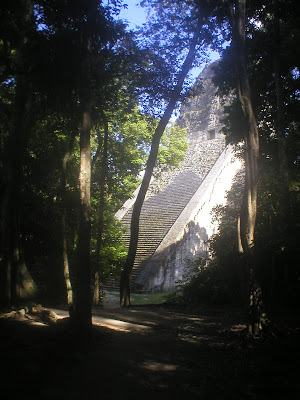There is an abundance of flint in the hills of the Petén area of Guatemala. They Mayans used flints for their tools and weapons. It is said 100,000 people lived here in its peak times. It has only been partially restored, and the process continues. They were working on the tallest temple in North America (pre skyscrapers, that is), Temple IV, during our visit last summer. They had built scaffolding on the top of the 212 ft. temple and were climbing up, over and around us barefooted, moving heavy rocks, while we sat looking out at the spectacular view. Pablo drew the vista (below).

The view from atop Temple IV, Tikal.

I was eavesdropping on the tourists who arrived huffing and puffing at the top, after the seemingly endless climb up the temporary makeshift stairs. I also enjoyed breathing in the clean rainforest scented breezes and looking out pensively at the top of the jungle canopy below. We sat there for over two hours. It was so serene. It was so thought-provoking. Trying to understand the history of this complex people is a constant challenge to me. I love a place like Tikal, where a person gets a real feel for the way life may have been. It is evident how temples were built over older temples, so I can get an idea of the timelines.
This is the campsite inside the park.

The palapa in the far corner shows our hammocks and mosquito nets. We camped out here for three days. There are three little restaurants within walking distance, where the food was reasonable and surprisingly good. Inside the park grounds are three small hotels, but they cost around $100 US per night. We were on a backpackers' budget, and frankly, we loved sleeping outdoors at the ruins. We saw lots of birds and wild animals, including howler monkeys swinging across the canopy next to us. Listening to howler monkeys is one of life's eye-widening events. They sound like lions, tigers, and bears. It is fascinating.
The jungle path into and through the park.

The back side of one of the main temples in the Acropolis.

The towering la ceiba tree is sacred. It symbolized the world-tree which unites the surface of the earth with nine levels of the underworld of Xibalbá.

Map of the main groups of buildings found at Tikal.

© 1997-2003 Studio360 Inc.-Destination360 All rights reserved.
The ball court.

Buildings in the Gran Plaza.

Stela are protected by palapas.

Walking through this area we saw toucans and parrots flying overhead, oscillated turkeys pecking around the grass, a snake crossed our path, spider monkeys swung through the trees, and we heard and watched several howler monkeys.








No comments:
Post a Comment